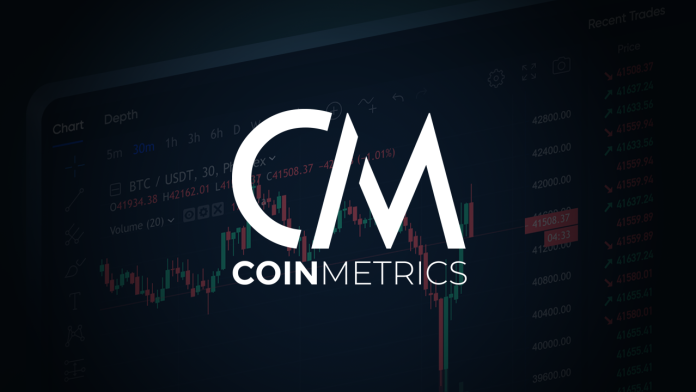tl;dr Summary: With public blockchains gaining in popularity, it has become increasingly important that the parameters to measure them are as accurate as possible. This will help businesses make better funding decisions, and also allows another avenue for the general public to perform research on a blockchain. Coin Metrics has come up with a solution.
Coin Metrics (CM), an open-source project started in 2017 to determine the economic significance of public blockchains, recently released a report explaining their approach to evaluating the on-chain volume metric of blockchains.
What is on-chain volume?
On-chain volume (value) is a metric that measures the number of coins/tokens traded on the blockchain. This is different from off-chain volume that measures coins/tokens traded outside the blockchain, such as in exchanges like Coinbase.
This measure is an indicator of the usage of the blockchain and can be used to predict gas fees as more volume will result in an increase in gas fees and vice versa.
The chart above shows three parameters in one. The black line indicates the price of Bitcoin (BTC) over time, the blue chart on the left shows the on-chain transaction value in BTC, and the green chart on the right shows the trading volume of BTC in exchanges.
Both the volume graphs represent the relationship between the price of BTC (left and right axis) and the volume in BTC (top axis).
How does Coin Metrics (CM) calculate on-chain volume?
Public blockchains, being distributed and open databases, allow anyone to access the history and transactions between users but this data is full of noise which often results in misrepresentation.
To help remove this noise, CM came up with a set of rules or “heuristics” to calculate transfer volume. The volume calculated, as a result, is called adjusted transfer volume.
These heuristics are based on an understanding of the source of noise and are grouped into two categories: adjustments needed for non-meaningful activity and adjustments arising due to the blockchain design.
Here are some examples of non-meaningful activities:
- Self churn: when the sender and receiver of funds is the same.
- Consolidation: when a user moves funds from different addresses into a single address.
- Exchanges: when funds are moved around, like an exchange moves funds to allow customer withdrawals.
- Mixers: when funds are moved around multiple times to obscure their origin.
- Spam: junk transfers like in-game messaging, statistics, advertisements, or a malicious attempt to clog the network.
- Other pass-throughs: other intermediary transactions.
Besides these, the blockchain design itself introduces a layer of complexity that needs to be factored in when deciding what heuristics to choose.
There are two main design philosophies: unspent transaction output (UTXO) and account-based. Bitcoin is an example of a UTXO type blockchain, whereas Ethereum is an account-based blockchain. CM chose one set of heuristics for UTXO and account-based blockchains shown in the diagram below.
Understanding the Heuristics
Obvious Change
UTXO type blockchains like Bitcoin behave like real-world currency because a transaction can lead to the remaining amount (change) transferred back to the sender. Let us take the below transaction as an example.
Here, the sender (debit address of 0JFN) is also credited the change of 0.0139 BTC back from the transaction and must not be counted as part of the value of this transaction.
To account for this, CM uses the heuristic called obvious change. This removes the amount flowing back into the sender.
According to their report, “Left uncorrected, obvious change outputs overstate transfer value by a factor of 5x or even 10x more versus when they are removed.”
Early Spend
Early Spend is another important heuristic that aims to identify non-meaningful activities like exchange activities, mixers, and spam. The research team at CM found out that the difference between these activities and regular payment transactions is the speed at which they occur.
The early spend heuristic discards transactions where the sender re-sends the funds to another address immediately after receiving them.
Here is one such example.
Funds from the original sender are received at 23:07 on 15th March 2022 and are transferred to another address at 23:10 on the same day.
Round Numbers (“Assumed Change”)
The next UTXO heuristic is called round numbers or assumed change. The rationale behind assumed change is that day-to-day commerce tends to gravitate towards easy-to-remember whole numbers.
Here is an example:
With this heuristic, the round number of 1BTC is considered the real value, and 1.389BTC is assumed as change and discarded.
Self Churn
This is similar to obvious change for UTXO type blockchains and removes transactions where the sender and the receiver are the same address.
Pass Throughs
Since account-based transactions lack a unique timestamp and reference, CM modified its early spend heuristic to include all transactions in one hour. If an account has received and then sent an equal amount in this time frame, it is considered pass-through and removed.
The picture below represents one such situation.
Account D is a clear example of a pass through having received and then sending the exact same amount to E and is removed from the total volume of this set of transactions. With this in mind, the total adjusted volume comes out to be 15+2+10+7+5+4=43.
Evaluating the heuristics
CM tested its heuristics by running it against specific on-chain events in the past. Known exchange activities like the Coinbase cold-wallet reshuffle in 2018 are good examples of such an event.
As seen in the chart graph above, the green line indicates the effect of this reshuffle on Bitcoin address balances. This reshuffle saw the exchange diversify from a few large wallets to several smaller wallets.
The red line is the percentage of BTC transfer volume removed from the baseline by the heuristic as self-churn, early spends, and change outputs because of the reshuffle.
A similar pattern is seen for Ethereum but the reshuffle seems to consolidate instead of diversify.
Applying these rules to other assets results in a table of their unadjusted and adjusted total value below.
To put these numbers in context, Visa (the credit card company) reported a total payments volume of $10.4T in 2021 compared to $4.7T for BTC.
Conclusion
CM has presented a valuable stepping stone for analysts and companies looking for reliable methods for assessing the overall health of a public blockchain economy. However, they also realize that big adjustments made because of one-off spike transfer volume warrant a second, deeper look to provide a more granular picture.
In the meanwhile, as technology grows and adoption increases, these heuristics will be put to test. CM realizes that and commits to exploring new ways to improve its estimates.






